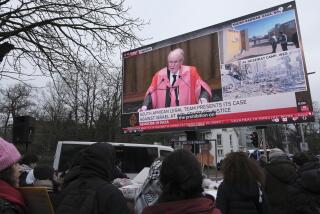Editorial: L.A. bricks its shot to get a free, privately-financed basketball court at Runyon Canyon Park
The city of Los Angeles – where no good deed goes unpunished. Two years ago, Neima Khaila, the CEO of a clothing company called Pink Dolphin, was hiking in Runyon Canyon Park and noticed a concrete slab that used to be a tennis court. With a buckled retaining wall above it and surrounded by rusty chain-link fence, the court was an eyesore.
Khaila called the Los Angeles Recreation and Parks Department with a proposal: He’d like to turn the tennis court into a basketball court. Sure, said the department. Can you build it and pay to maintain it for a decade? And by the way, can you also replace the retaining wall, the chain link fence and install a drinking fountain? Khaila agreed to it all, at an estimated cost of $260,000, plus the time and energy it would take to get approvals and find companies that met the city’s requirements to do the work. In recognition for his donation, the department would let him put the Pink Dolphin logo on the basketball court.
Going forward, the Recreation and Parks Department ought to develop clear policies on when, where and how sponsors may put logos on public property.
Fast forward two years: When some neighbors and park users finally learned about the basketball court, they went ballistic. They said they had never been notified or consulted on the project, they didn’t want a basketball court in their urban wilderness – and that the placement of a giant corporate logo on the court was far too much commercialization for a park. They sued, arguing that the city had improperly exempted the project from environmental review before approving it.
On Wednesday, the Board of Recreation and Parks Commissioners rescinded their approval of the basketball court project. Councilman David Ryu, who represents the community around Runyon Canyon, said the city will reimburse Khaila for the $210,000 he has spent so far on the retaining wall, using parks money and City Council discretionary funds. The city will no longer get the basketball court or the water fountain; it will have to pay for the retaining wall that could have been completed for free, and there’s less money available for other valuable park and community projects. And in the future, what sane business person would want to donate his or her time, money or services to the city after watching the Pink Dolphin debacle?
Here’s the problem: The city of L.A. doesn’t have enough money to maintain its parks. The department has a backlog of basic maintenance projects. Runyon Canyon Park, for example, is an immensely popular regional park with 1.8 million visitors a year (along with 300,000 dog visitors), but it suffers from trail erosion and a lack of basic facilities, such as bathrooms. This is not a dilemma unique to Los Angeles. State parks and national parks are also chronically underfunded and have long lists of deferred maintenance projects. In an ideal world, cities, states and the federal government would adequately fund public parks. But in the great scheme of governmental priorities and obligations, from public safety to education to pensions, parks get short shrift. That’s why officials increasingly see public-private partnerships as one way – sometimes the only way – to get valuable park projects done.
No one particularly likes this solution. And if residents feel strongly opposed, they’re going to have to tax themselves more to pay for these projects.
But if government goes forward with public-private partnerships, it must do so without allowing the crass commercialization of precious park space or letting corporate sponsors dictate park policy. Cities and states should not put public spaces up for sale to the highest bidders.
Going forward, the Recreation and Parks Department ought to develop clear policies on when, where and how sponsors may put logos on public property. The lesson from the bungled Runyon Canyon basketball court is that if parks officials want to incorporate private investment in a way that enhances public assets, they’re going to have to work more closely with park users.
Follow the Opinion section on Twitter @latimesopinionand Facebook
More to Read
A cure for the common opinion
Get thought-provoking perspectives with our weekly newsletter.
You may occasionally receive promotional content from the Los Angeles Times.






